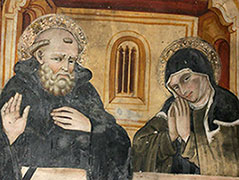
 |
|
|

February 10th is the Feast of St. Scholastica, the sister of St. Benedict. What we know about the life of St. Benedict, we owe to Pope St. Gregory the Great who wrote his biography roughly fifty years after St. Benedict's death (c. 594 AD). In the Second Book of the Dialogues Containing the Life and Miracles of St. Benedict of Nursia the Pope tells his disciple Peter of the wondrous miracles wrought by St. Benedict. There was one time, however, when the saint did not get his way. Pope Gregory recounts: I must needs tell you, how there was one
thing which the venerable Father Benedict would have done, and yet he could not. ANTIPHONS FROM THE OFFICE OF ST. SCHOLASTICA FROM THE DIALOGUES OF POPE ST. GREGORY THE GREAT
When St. Gregory's disciple Peter, who knew the power of St. Benedict through his miracles, wondered why in this instance St. Benedict did not get his way, Pope St. Gregory explains that St. Scholastica was "...able to do more because she loved more/Plus potuit quia plus amavit." Though she did not tell him why, she intuited that her death was near.  by Giacomo Manzù Three days after his encounter with his sister, St. Benedict, while standing in his cell, and looking up to heaven, "...beheld the soul of his sister (which had departed from her body), in the likeness of a dove to ascend into heaven." For this reason St. Scholastica is usually represented holding a dove. The stunning tabernacle in the Regina Laudis Church Jesu Fili Mariae, free standing and carved from rough cut granite, has two doves on top representing St. Benedict and St. Scholastica. While in Rome, Mother Praxedes Baxter worked with the renowned sculptor, Giacomo Manzù, beloved friend of Pope St. John XXIII. Manzù gave the Abbey his priceless designs of wheat, grapes, and the cross, which were then etched into the bronze doors and a panel behind the tabernacle. The Feast of St. Scholastica holds special meaning for our community, for on this day in 1976, our Foundress, Lady Abbess Benedict Duss, received her Abbatial Blessing and the Monastery of Regina Laudis was elevated to the status of an Abbey. Almost 40 years later at the time of her Abbatial Blessing, Mother Abbess Lucia Kuppens took as her abbatial motto: "Plus potuit quia plus amavit."  unknown , 15th century, Nursia She has an exalted image of Benedict’s calling, and in prayer she receives such certainty in this regard that she never doubts his mission. If it ever happens that all seems hopeless and he is at a loss about everything, then she is there to give him great consolation. She knows that things will work out. If she brings him the encouragement he needs, then it is not simply as one human being to another, but she brings it with the entire weight of the Church and the monastery. She brings him this consolation as the fruit of her prayer and in her complete femininity.
From the Book of All Saints by Adrienne von Speyr
|
||||||||||
| Copyright © 2013 Abbey of Regina Laudis. All rights reserved. | |||||||||||